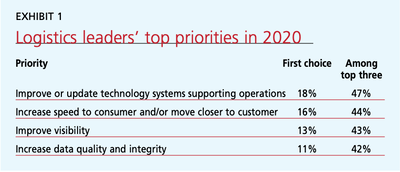The rise of the next-generation 3PL
THIRD-PARTY LOGISTICS

For years, freight managers and logistics service providers have leveraged the value of relationships, those whom you’ve worked with successfully in the past, as the door-opener to engaging and retaining clients and service providers. It has been a fairly common practice for logistics managers, as they moved to new companies, to bring along their third-party logistics service providers, or 3PLs.
That certainly still happens today. Yet the speed and scope of change in how shippers engage and utilize 3PLs, and the emergence of new enabling technologies, have created more complex, demanding, and data-driven service requirements that are foreshadowing the rise of the next-generation 3PL.
These next-generation players and their service portfolios are defined by speed, agility, adaptability, and continuous improvement. They have to operate reliably and seamlessly in an e-commerce-defined world. They are embracing digitization and technology for automating manual processes and creating even more data. And perhaps most important, they’re emerging as an “integration hub” connecting a far more diverse and interdependent set of systems, technology platforms, and data sources across the supply chain than ever before.
Most 3PLs will say that it’s still a relationship-based business. Yet while an important factor, for next-generation 3PLs, “our value has to go deeper than someone you knew,” says Tom Curee, senior vice president of strategy and innovation for West Chester, Ohio-based 3PL Kingsgate Logistics. “The whole evolution of technology has been transformative for us. It’s challenged us in a healthy way … we are taking a much more customized approach to solutions [yet] we don’t want [the customer] to lose that personal touch and experience,” he says.
Shippers are looking more and more to their 3PLs to lead the charge in providing process automation and integration between what have been disparate systems and sources of logistics information, observes Erin Van Zeeland, group senior vice president for Green Bay, Wisconsin-based Schneider Logistics, one of the industry’s largest providers of transportation management and logistics services. “It’s critical for a TMS [transportation management system] and the underlying technology [to have] the ability to integrate with third-party best-of-breed platforms,” she says. “Connectivity through APIs [application programming interfaces] for third-party data is happening at an accelerated pace [so] you have to be nimble.”
Among the third-party software platforms that Schneider has integrated with are Trucker Tools, for freight matching, automated load booking through its Book It Now app, and shipment visibility with small fleets and independent truckload operators; and Truckload.com, for automated booking of truckload shipments with third-party carriers.
Shipper expectations for, among other things, real-time visibility, innovation, and responsive, flexible service options reflect the undeniable influence of the Amazon-driven online buying experience enjoyed by today’s consumers. That’s a key driver behind the next-gen 3PL evolution, she notes.
“We as consumers have a completely different expectation than what existed years ago with visibility,” Van Zeeland explains. “In our personal experiences, we like the Amazon model and so do our customers,” she says, noting that Schneider Logistics and its customers are focused on driving more connected, automated, and intelligence-based processes. At the end of the day, it’s about breaking down silos and bringing timely, accurate data and quality decision metrics to the shipper’s table. “What was once tribal knowledge within an organization is now very much accessible,” she says.
A BRIGHT FUTURE FOR OUTSOURCING
Will outsourcing remain a key strategy for shippers as needs rapidly evolve, technology continues its inexorable march, and the next generation of 3PLs negotiate a winding path of change?
Without a doubt, says Geoff Turner, president and chief executive officer of Choptank Transport, a $300 million national 3PL and freight brokerage firm based in Preston, Maryland. “The significant investments 3PLs are making will keep outsourcing attractive because most shippers can’t keep up with the pace of technology development on their own,” Turner says. “They want to focus on their core competencies and let their 3PLs continue to invest on the logistics tech side.”
For Turner, keeping up with the pace of technological change—and customer demand for the newest and greatest—is the biggest challenge. “Our backlog of technology integration work is huge,” as shippers increasingly want more sophisticated tools and faster access to more data, more frequently, he says. One challenge he sees is continually educating shippers on just which technologies are most important and relevant to their needs, are effective and deployable, and properly align with and support joint goals and objectives.
“Five years ago, there were a handful of solutions” shippers and 3PLs would consider, says Turner. “Now there are dozens.” Consequently, shippers “are inundated with a barrage of ‘bells and whistles,’ which makes it a challenge to know what’s real and what’s marketing hype.”
Strip away all the hype, and “what [shippers] are really looking for,” Turner says, “is a solution or a set of capabilities that resolve two or three key recurring challenges.” In his experience, those are a robust visibility platform, with high carrier compliance providing automated visibility data end to end; algorithm-driven predictive freight-matching to automate matching and booking of truck to load; and optimizing the process to ensure Choptank is running the customer’s freight to minimize cost while maximizing capacity utilization and velocity.
Which, he adds, is also high on the list of tech features and capabilities desired by the thousands of small fleets and independent owner-operators that Choptank relies on for truckload capacity. “It’s all about the carrier experience, reducing friction, being easy to work with. We have to make sure we keep them in business, help them be efficient, and give them the tools, quality loads, and reloads they need to consistently maximize the hours they have to generate revenue,” Turner stresses.
Schneider’s Van Zeeland echoes his point about supporting the small truckload fleet operator and providing them with a positive experience through the entire cycle. “Our data shows that almost 90% of the carrier base [in truckload] is [fleets with fewer] than five trucks,” she notes, adding that Schneider Logistics works with thousands of carriers.
“Reaching out to, working with, and optimizing [small carrier] capacity is critical. We’re meeting the carriers where they are,” she says, explaining that this means deploying mobile-friendly technology that helps carriers streamline interactions, book the best loads in their preferred lanes, and execute transactions in a more automated way that saves time for both broker and carrier. It’s an approach designed to build trust and encourage collaboration, and demonstrate respect, understanding, and a willingness to help small carriers overcome the daily challenges they face to make a fair profit.
THE NEXT GENERATION: IS IT A 3PL OR 4PL?
To be a next-generation 3PL—or 4PL, a kind of uber-logistics service provider whose responsibilities may extend to managing a client’s other 3PLs—means responding faster to evolving shipper needs for more complex and sophisticated logistics planning and execution capabilities. These demands will expand the scope and scale of potential services 3PLs can weave deeper into the fabric of a shipper’s supply chain.
And the opportunity to redefine and expand their value through more automated, technology-driven—and profitable—services.
In a November 2019 report titled The Rise and Future of the 4PL Model, Gartner analysts Courtney Rogerson and David Gonzalez note that “managing ever-increasing logistics complexity while simultaneously improving visibility is a top priority and growing challenge for most shippers today—especially as the number of external partners and customers in the supply chain ecosystems grows.”
Furthermore, in an earlier research report, the 2019 Logistics Outsourcing Strategy Survey, Gartner polled 190 respondents, all senior logistics and supply chain operators, on their top three logistics priorities over the next 12 months. Almost half of the logistics leaders surveyed said updating their technology systems, increasing speed to customer, and improving visibility were their most important goals for the coming year (see Exhibit 1).
 The study noted that “many survey respondents are focused on increasing technology capabilities that will concurrently improve visibility, data quality, and integrity, and decrease data gaps.” All of which provides an interesting strategic road map for today’s 3PLs to design and develop next-generation capabilities—or enhance those that exist today.
The study noted that “many survey respondents are focused on increasing technology capabilities that will concurrently improve visibility, data quality, and integrity, and decrease data gaps.” All of which provides an interesting strategic road map for today’s 3PLs to design and develop next-generation capabilities—or enhance those that exist today.
WOE BE THE SMALL BROKER?
Is there still a place in the market for the smaller, high-touch, service-oriented freight broker? Absolutely, says Andy Dyer, president of Chicago-based New Age Logistics, which is part of the Evans network of companies and which provides truckload brokerage and value-added logistics services. “Shippers have much bigger expectations of responsiveness,” says Dyer. “While we’re a smaller broker, we are often more agile, can respond faster, and can be more flexible—at a price point that has great value for the shipper,” he notes.
The infusion of capital into the logistics space and the resulting proliferation of technology choices means that even smaller players can compete with, out-hustle, and outperform many of the larger firms, he believes. In his view, the logistics tech revolution has completely upended the landscape, bringing advanced platforms and low-cost, cutting-edge capabilities to the masses. These are enabling quicker decisions, shorter implementations, easier training, and faster ramp-up to return on investment.
“You don’t have to run $5 billion worth of freight through your [in-house] system anymore to make the technology pay back,” Dyer notes. “You can run $100,000 worth of freight through, and it will work [and give you payback]. And [with APIs and pre-built integration modules], implementation is far faster and much more straightforward—with the go-live conversations starting at 30 to 45 days.”
Even with a new generation of 3PLs on the cusp, some basic fundamentals will never change, Dyer believes. “It’s very simple: Make your actions match your words,” he says, which is especially important in building and maintaining sustainable relationships with carriers. “Sell the load as it really is and make it easy for them to tender, track, and bill.”
His last piece of advice: “Dial down the hassle factor. Five different brokers at the same firm will have five different shipments with the same carrier, and all five are calling the dispatcher asking ‘Where’s my freight?’ It’s madness,” he says. “With the proliferation of GPS-enabled smartphones and driver apps … there should be no reason today for a broker to call a driver and ask where the freight is.”
Related Articles

Copyright ©2024. All Rights ReservedDesign, CMS, Hosting & Web Development :: ePublishing